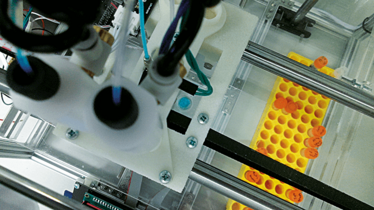Bioprinting Better Drug Development
Parallel to the development of 3D printing and additive manufacturing techniques using polymers and metals, another set of novel techniques has been developed that can print living biological cells.

Only a fraction of drug candidates that begin pre-clinical testing are ever approved for human use. The low success rate can be partly attributed to the differences in response between humans and the animal models currently used for testing.
Parallel to the development of 3D printing and additive manufacturing techniques using polymers and metals, another set of novel techniques has been developed that can print living biological cells. By encapsulating cells inside a gel, complex 3D structures can be printed with cells suspended throughout the structure. The cells grow and multiply within the structure, creating their own matrix and forming tissues. By using organ-specific cells generated from pluripotent stem cells, it should be possible to bioprint 3D organ-specific micro-tissues that replicate the response and functions of a human organ, but on a much smaller scale. These could be used for testing the response of human cells to drugs.
The first bioprinter I built was originally designed to quickly and reliably position viable human stem cells into predetermined patterns and locations to help study stem cell biology (1). But once it was built, it became apparent that it was capable of far more interesting and complex tasks, ranging from automatically populating microwell plates with greater accuracy and speed than pipetting, all the way to creating complex 3D structures with multiple different types of viable biological cells.
Although at first glance the technology behind bioprinting seems similar to the techniques used in 3D printing, bioprinting is actually more closely related to traditional 2D inkjet and laser printing. The first bioprinting experiments (originally called “cytoscribing”) were carried out in the 1980s; roughly the same time as the early additive manufacturing techniques were being invented. Bioprinting and additive manufacturing were developed largely in isolation, although structures created using additive manufacturing techniques have been used as scaffolds for living cells.
It’s actually not that difficult to build a bioprinter – if you can build a 3D printer then you could probably build a simple bioprinter. However, if you wanted to use it to create 3D structures with stem cells (which are quite fragile) then you’d have to spend a lot of time determining the correct setup and the make-up of the matrix material to support the cells and ensure it was compatible and printable. We have created several generations of bioprinting platforms that are being used by our collaborating labs around the world. We have validated the bioprinter’s capabilities by printing 2D arrays of biomaterials, checking its compatibility with living cells (including stem cells, which were unaffected by the printing process), and creating 3D spheroid aggregates of cells.
Our current focus is on creating micro versions of human organs from human cells. One stumbling block for the creation of larger tissues is integrating a network of blood vessels to keep the cells supplied with nutrients and remove waste. But it is still early days and in the future, researchers may be able to print whole organs.
- Alan Faulkner-Jones et al., “Development of a Valve-Based Cell Printer for the Formation of Human Embryonic Stem Cell Spheroid Aggregates,” Biofabrication 5(1) (2013).
Alan Faulkner-Jones is Research Associate in Bioengineering (Biofabrication), at Heriot-Watt University, UK.



















